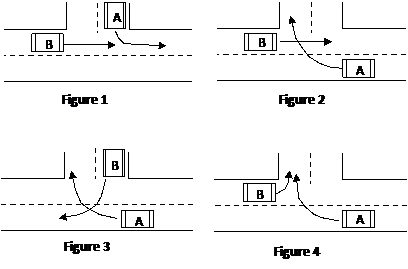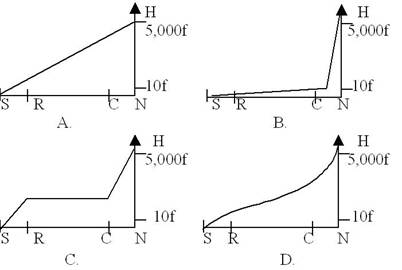
. Before he went abroad,he spent as much time as he _____ English.
A. could learning B. learned C. to learn D. could learn
 计算高手系列答案
计算高手系列答案科目:高中英语 来源: 题型:阅读理解
In a natural disaster—a hurricane,flood,tornado,volcanic eruption,or other calamity—minutes and even seconds of warning can be the difference between life and death.Because of this,scientists and government officials are working to use the latest technological advances to predict when and where disasters will happen.They are also studying how best to analyze and communicate this information once it is obtained.The goal is to put technology to effective use in saving lives and property when nature unleashes its power with devastating results.
On September 29,1998,Hurricane Georges made landfall in Biloxi,Mississippi,after devastating Haiti,the Dominican Republic,Puerto Rico,and several islands of the Caribbean with torrential rains and winds up to 160 km/h (100 mph).Few people lost their lives along the Gulf Coast of the United States,although hundreds died in the Caribbean.
This was a very different outcome from 1900,when a powerful Gulf Coast hurricane made an unexpected direct hit on Galveston,Texas,killing at least 6 000 people.Vastly improved hurricane warnings explain the different circumstances at either end of the 20th century—residents of Galveston had no advance warning that a storm was approaching,while residents of Biloxi had been warned days in advance of Georges’s approach,allowing for extensive safety precautions.
At the same time that people in Biloxi were thankful for the advance warning,some residents of New Orleans,Louisiana,120 km to the west,were less satisfied.A day before Georges made landfall,forecasters were predicting that the hurricane had a good chance of striking New Orleans.Because much of New Orleans lies below sea level,the city is at risk for flooding.In addition,because New Orleans has a large population in vulnerable locations,emergency management officials must begin evacuations well before a storm strikes.But evacuation costs money:Businesses close,tourists leave,and citizens take precautionary measures.The mayor of New Orleans estimated that his city’s preparations for Georges cost more than 50 million.After the full fury of Georges missed New Orleans,some residents questioned the value of the hurricane forecasts in the face of such high costs.
The differing views on the early warnings for Hurricane Georges illustrate some of the complexities involved in predicting disasters.Disaster prediction is more than just forecasting the future with advanced technology—it is also a process of providing scientific information to the government officials and other decision makers who must respond to those predictions.
In general,the process has three phases.First,there is the challenge of forecasting the event itself.In the case of Georges,scientists worked to predict the future direction and strength of the hurricane days in advance.
A second important challenge is communicating the forecast to decision-makers.Because forecasts are always uncertain,a central factor in disaster predictions is communicating this uncertainty.Uncertainty is usually described in terms of odds or probabilities,much like daily weather forecasts.The media plays an important role in communicating predictions and their uncertainty to the public.
The third part of the process is the use of predictive information by decision makers.Even the most accurate information is of little value if the decision maker does not use it appropriately,for example in deciding whether to order an evacuation.If there is a breakdown in any of these three phases of prediction,the result is increased danger and a higher risk of loss of life.
The underlined word“calamity”refers to ______.
A.nature B.thunderstorms C.disaster D.dangers
According the passage,the purpose of disaster prediction is to______.
A.demonstrate the power of advanced technology
B.bring out the truth between life and death
C.prevent such natural disasters from happening
D.reduce human casualties and loss of property
Which of the following areas suffered the most severe damage?
A.Biloxi,Mississippi. B.Gulf Coast of U. S.
C.Galveston,Texas. D.New Orleans.
查看答案和解析>>
科目:高中英语 来源: 题型:阅读理解
Driving in a foreign country is always different in at least some ways from driving in your own country. Here are some general points regarding driving in New Zealand.
Visitors wishing to drive in New Zealand do not require an international driver’s license but are required to carry their local driver’s licens![]() e whenever driving.
e whenever driving.
Vehicles drive on the left-hand side of the road as they do in Britain, Australia, and Japan. Most rental vehicles will have a sticker reminding you of this important fact.
When the traffic light is red, you must stop. There is no left turn rule as in North America.
New Zealand road rules follow international standards but please note that in New Zealand vehicles turning left must give way to traffic turning right.
In general, if you are turning left (where there are give-way signs or no signs), give way to vehicles that not turning. In all other situations, give way to vehicles crossing or coming from your right.
Seat belts must be worn at all times while driving in New Zealand. This stands for the driver and passengers. The driver is responsible for ensuring all passengers are wearing their seatbelts.
Do not drink alcohol before driving in New Zealand—drinking and driving laws are strictly enforced.
Speed limits are in kilometres per hour (kph), not miles per hour (mph).
Speed conversion: 1 kph equals 0.621 mph; 1 mph equals 1.61 kph.
The speed limit on the open road is 100km/h. In towns and cities the speed limit is 50km/h. Be sure to obey all school crossing speed reductions as speed cameras operate regularly throughout New Zealand.
For further information and up to date road conditions visit: http://www.transit.govt.nz
What can be learned from the passage?
A. A passenger’s not wearing the seat belt has little to do with the driver.
B. There will be a reminder for drivers to remember to drive on the left side.
C. Cars passing a school in towns should drive at a speed of less than 31 mph.
D. A foreign driver is expected to have a driving license issued by New Zealand.
Which of the following statements correctly explains road rules in New Zealand?
A. In Figure 1, Car B must give way to Car A.
B. In Figure 2, Car B must give way to Car A.
C. In Figure 3, Car B must give way to Car A.
D. In Figure 4, Car B must give way to Car A.
 |
This passage is most likely ____________.
A. a travel brochure for locals
B. a website travel introduction
C. an advertisement of travel
D. a travel column in a geographical magazine
查看答案和解析>>
科目:高中英语 来源:2013届辽宁省丹东市宽甸二中高三上学期期末考试英语试卷(带解析) 题型:阅读理解
Suppose that we lined up our roughly 14 million United States businesses in order of size, starting with the smallest, along an imaginary road from San Francisco to New York. There will be 4,500 businesses to the mile, or a little less than one per foot. Suppose further that we planted a flag each business. The height of the flag pole represents the yearly volume of sales (销量) , each $ 10, 000 in sales in shown by one foot of pole.
The line of flagpoles is a very interesting sight. From San Francisco to about Reno, it is almost unnoticeable, a row of poles about a foot high. From Reno eastward the poles increase in height until, near Columbus, Ohio - about four - fifths of the way across the nation - flags fly about 10 feet in the air.
But as we approach the eastern terminus (终点) , the poles suddenly begin to mount (升高) . There are about 300, 000 firms in the country with sales over $ 500, 000. These firms take up the last 75 miles of the 3,000 - mile road. There are 200, 000 firms with sales over $ 1 million. They take up the last 50 miles. Then there are 1, 000 firms with sales of $ 50, 000, 000 or more. They take up the last quarter of a mile before the city limits, flags flying at cloud height, 5 , 000 feet up .
At the very gate of New York, on the last 100 feet of the last mile , we find the 100 largest industrial firms . They have sales of at least $ 1.5 billion, so that their flags are already miles high. Along the last 10 feet of road , there are 10 largest companies . Their sales are roughly $ 10 billion and up : their flags fly 190 miles in the air , almost in the stratosphere (平流层) .
【小题1】What is the author’s main purpose in this passage?
| A.To tell the reason why the largest firms are in New York. |
| B.To show the geographical distribution (分布) of the United States businesses. |
| C.To provide a general idea of the size of businesses in the United States. |
| D.To tell us how the United States businesses are arranged. |
| A.San Francisco, Reno, New York, Columbus. |
| B.San Francisco, Reno, Columbus, New York. |
| C.New York, Columbus, Reno, San Francisco |
| D.New York, Reno, Columbus, San Francisco |
| A.The last 75 miles. | B.The last 50 miles. |
| C.The last 100 feet of the last mile. | D.The last quarter of a mile |

查看答案和解析>>
科目:高中英语 来源:2010年福建省八县(市高一下学期期末联考英语卷 题型:阅读理解
Learning Chinese has been like climbing a steep(陡峭的)mountain.
My mother was born in Tokyo,while my father moved from Shanghai to Hong Kong when he was seven years old. At home we speak English. I know some basic Chinese customs :to use chosticks gracefully (得体地)and what to say on Spring Festival to get a red envelope. But I never truly learned to speak Chinese.
Why should I need to learn the language ,anyway? I live in America where everyone speaks English.
I realized I was wrong in ninth grade when I arrived at Philips Academy,a famous boarding school in Massachusetts.The school encourages a global outlook(视野). There I decided to welcome the opportunity to learn Chinese. I met other American-born Chinese and together we spoke Ching-lish outside of the classroom.
I searched for ways to access Chinese culture through dramas such as Meteor Garden (《流星花园》)and music by singers such as S.H.E,Wilbur Pan and Jasmine Leung(梁静茹). Listening to Chinese music is where I found my favorite singer in the whole world:Jay Chou. Even if I cannot understand what he is crooning(哼唱), I do feel more Chinese whenever I listen to his music.
Last summer I spent five weeks in China,four of which were taking a language course at a Beijing high school. I was proud when I could understand the dialogue in Intitial D(《头文字D》) and when I could easily translate Fairy Tale sung by Kong Leung(光良).
Learning Chinese has been a rocky trek(艰苦跋涉), and I know it will continue to be that way before I arrive at a relative plateau(高地) of fluency(流利).I hope that one day I will be able to work and maybe even live in China as a true Chinese.
1.The author wrote the text mainly to___.
A.share her experience of learning Chinese
B.tell us why she is interested in learning Chinese
C.show off(炫耀) the progress she made in learning Chinese
D.give advice on how to learn Chinese
2.The author's attitude to learning Chinese changed because___.
A.she found Chinese was interesting to learn
B.she wanted to take a course to pass easily
C.she realized she should have an open mind to the outside world
D. she made friends with some American___born Chinese at the school she studied
3.The author tried all of the following to learn Chinese EXCEPT___.
A.listening to Chinese music
B.practicing speaking Chinese with her parents
C.enjoying Chinese dramas
D.taking a Chinese course in China
4.We can learn from the text that___.
A.S.H.E.is the author's favorite singer[来源:Zxxk.Com]
B.dialogues in Meteor Garden are easy to guess
C.the author enjoys learning Chinese though it is difficult
D.the author can speak fluent Chinese now
查看答案和解析>>
科目:高中英语 来源:2010年福州八县协作校高二联考 题型:阅读理解
We’ve used the wind as an energy source for a long time. The Babylonians and Chinese were using wind power to pump water for irrigating crops 4,000 years ago, and sailing boats were around long before that. Wind power was used in the Middle Ages, in Europe, to grind(磨碎) corn, which is where the term “windmill” comes from.

We can use the energy in the wind by building a tall tower, with a large propellor(螺旋桨) on the top. The wind blows the propellor round, which turns a generator to produce electricity. We tend to build many of these towers together, to make a “wind farm” and produce more electricity. The more towers, the more wind, and the larger the propellors, the more electricity we can make. It’s only worth building wind farms in places that have strong, steady winds, although boats and caravans(大篷车)increasingly have small wind generators to help keep their batteries charged.
The best places for wind farms are in coastal areas, at the tops of rounded hills, open plains and gaps in mountains — places where the wind is strong and reliable. Some are offshore. To be worthwhile, you need an average wind speed of around 25 km/h. Most wind farms in the UK are in Cornwall or Wales. Isolated places such as farms may have their own wind generators. In California, several “wind farms” supply electricity to homes around Los Angeles.
The propellors are large, to obtain energy from the largest possible volume of air. The blades can be angled to cope with varying wind speeds. Some designs use vertical turbines (垂直涡轮机), which don’t need to be turned to face the wind. The towers are tall, to get the propellors as high as possible, up to where the wind is stronger. This means that the land beneath can still be used for farming.
1.The first paragraph aims to introduce to us _______.
A. the function of wind power B. the source of wind power
C. the nations using wind power D. the history of using wind power
2.The best places for building the wind farm are places where _______.
A. boats and caravans can often be seen B. isolated farms don’t have enough electricity
C. there are less human activities D. the wind is strong and reliable
3.We can infer from the passage that _______.
A. wind farms will not take up too much farming land
B. wind farms need no fuel because wind is free
C. the blades can be angled to turn to face the wind wherever it comes from
D. the higher and larger the towers are, the stronger the wind is
4.What can be a suitable title for the passage?
A. Where to build a wind farm. B. ABC of the using of wind energy.
C. How to make best use of wind. D. Wind energy is the best energy.
5.The underlined sentence in the last paragraph means______________________.
A. The blades can increase wind speeds
B. The blades can decrease the wind speeds
C. The speed of blades can be changed.
D. The blades can be adjusted to face different wind speeds
查看答案和解析>>
湖北省互联网违法和不良信息举报平台 | 网上有害信息举报专区 | 电信诈骗举报专区 | 涉历史虚无主义有害信息举报专区 | 涉企侵权举报专区
违法和不良信息举报电话:027-86699610 举报邮箱:58377363@163.com